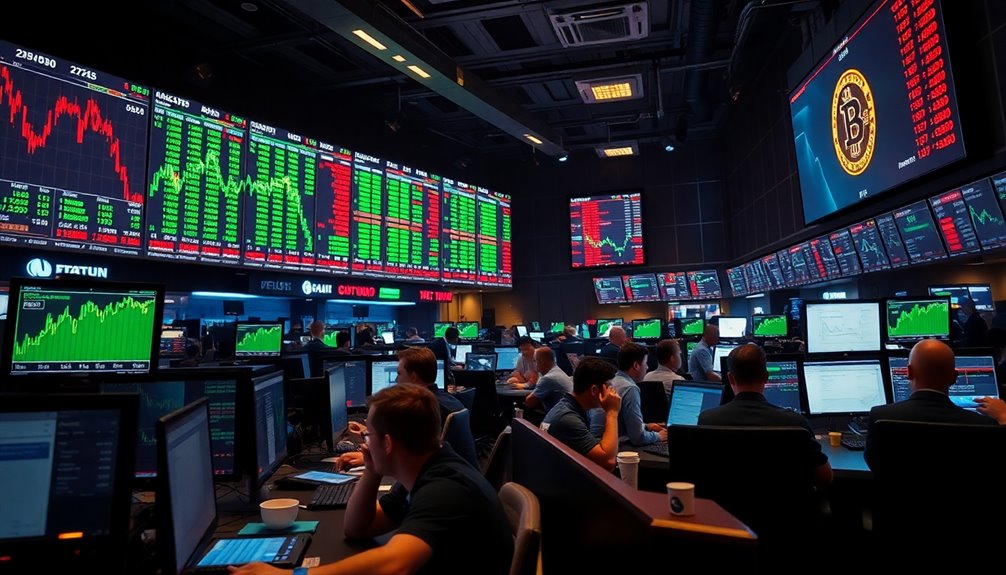Bitcoin's stunning surge past $100,000 is creating a frenzy in U.S. crypto stocks, with many soaring in response to this milestone. You'll notice how optimism among retail and institutional investors is intensifying, as major players like MicroStrategy scoop up vast amounts of Bitcoin. Regulatory shifts promise a more favorable climate for crypto, adding to the excitement. As the market anticipates potential ETF approvals and maintains high liquidity levels, bullish sentiment is palpable. Curious how these factors weave together to shape the market? There's even more to uncover about this fascinating development.
Key Takeaways
- Bitcoin's surge past $100,000 has sparked renewed optimism among investors, driving significant interest in U.S. crypto stocks.
- Institutional investments, like MicroStrategy's $1.5 billion Bitcoin acquisition, are fueling confidence in the crypto market.
- Positive regulatory developments, including a pro-crypto stance from President-elect Trump, further enhance market legitimacy and investor interest.
- Increased demand for call options reflects the bullish sentiment surrounding Bitcoin's price movements and potential future gains.
- Historical trends indicate that Bitcoin's price typically rises in December, contributing to the current market enthusiasm and investor engagement.
Causes of the Surge

Driving the recent surge in Bitcoin's value are several key factors, primarily rooted in an evolving regulatory environment, increased interest from both institutional and retail investors, and positive market dynamics.
President-elect Donald Trump's pro-crypto stance boosts market optimism, while the nomination of Paul Atkins as SEC chair is expected to ease regulatory barriers. With Gary Gensler's impending departure, known for his strict enforcement, investor confidence rises even further. Additionally, Bitcoin's milestone achievement of surpassing $100,000 has further fueled investor enthusiasm.
On the investment front, institutional interest is surging, highlighted by MicroStrategy's acquisition of 15,400 more bitcoins for $1.5 billion. The launch of cash-settled index options linked to Bitcoin by Cboe Global Markets also enhances trading flexibility.
Plus, reports of Trump Media & Technology Group eyeing crypto investments add to the growing market confidence.
This excitement isn't limited to institutions; retail interest is expanding rapidly, supporting Bitcoin's upward momentum. In November, Bitcoin experienced a remarkable 37% surge, signaling potential for further growth as it historically performs well in December.
All these elements combined create a perfect storm, propelling Bitcoin's value into the stratosphere.
Market Reaction Overview

As Bitcoin's price skyrockets, you're likely noticing a noticeable shift in market sentiment, with optimism surging among investors. This newfound enthusiasm isn't just limited to Bitcoin; crypto-related stocks are also benefiting from the momentum. With this dynamic playing out, it's essential to understand how these price movements impact overall market performance. The recent surge in Bitcoin's price is largely attributed to Trump's reentry to the White House, signaling a potential shift in regulatory approaches that could further benefit the crypto market.
Price Surge Dynamics
In the wake of Bitcoin's meteoric rise to $100,000, market reactions have been shaped by several key factors.
First, institutional investments have played a pivotal role in driving this surge. You might notice that large financial players are increasingly allocating resources to Bitcoin, signaling confidence in its long-term potential. This influx of capital has created a robust support system for the price increase. Notably, continued accumulation by institutions indicates a strong belief in Bitcoin's long-term value store.
Additionally, there's a sense of regulatory optimism surrounding Bitcoin. With expectations of a pro-crypto regulatory environment under the incoming Trump administration, investors feel encouraged to engage more aggressively in the market. This optimism fuels buying activity, further propelling the price.
Lastly, despite a slight contraction in the Global M2 money supply, global liquidity remains relatively high. You might find that this liquidity helps sustain the upward momentum, as investors seek alternative assets like Bitcoin to hedge against inflation or currency devaluation.
All these factors combined create a powerful dynamic, enabling Bitcoin's price to soar and sending U.S. crypto stocks into orbit. Keep an eye on these drivers as they'll likely shape future market movements.
Market Sentiment Shift
Following Bitcoin's rise above $100,000, market sentiment has shifted dramatically toward optimism and bullishness. The surge in demand for call options reflects this newfound confidence, especially after the U.S. presidential election. Historically, Bitcoin has shown a pattern of December price increases following halvings, and this trend adds to the anticipation of further gains. With the U.S. stock market's Christmas rally expected to amplify optimism, investors are keen to see how high Bitcoin can go. Additionally, the total cryptocurrency market capitalization surged over $1 trillion, marking a 45% increase, which further fuels investor enthusiasm. The nomination of Paul Atkins as SEC chair signals a regulatory shift that could foster a more crypto-friendly environment, boosting institutional confidence. This change, combined with the resignation of Gary Gensler, reduces litigation pressure, enhancing the outlook for altcoins like XRP. Additionally, the anticipated approval of spot Bitcoin ETFs further legitimizes Bitcoin as an essential portfolio asset.
Crypto Stock Performance
The recent surge in Bitcoin's price has sparked significant interest in crypto stocks, reshaping market dynamics. As institutional investors increasingly view Bitcoin as a legitimate asset class, stocks tied to the crypto market are experiencing unprecedented growth. Companies like MicroStrategy have showcased aggressive investment strategies, which further fuels optimism.
If sizable retirement funds begin allocating even a fraction of their assets to Bitcoin, you could witness an explosive demand surge. Notably, crypto trading volume surged to over $10 trillion in November, highlighting the growing interest in the market.
Regulatory changes also play a pivotal role in this market reaction. With Paul Atkins nominated to lead the SEC, expectations for a friendlier regulatory approach are rising. This shift could enhance institutional confidence and encourage more investments in crypto stocks.
Market activity reflects this enthusiasm, as trading volumes soared to over $10 trillion in November. Bitcoin's recent leap past $100,000 brought along a new benchmark, pushing its value compared to gold to unprecedented levels.
However, volatility remains a concern. While many stocks have surged, some traders are hedging against potential pullbacks, mindful of past market collapses. Ultimately, the crypto stock performance mirrors the excitement and risks tied to Bitcoin's meteoric rise. This dynamic has left investors walking a fine line between optimism and caution, as unpredictability looms large in the market. Analysts have pointed to the 100k bitcoin inferno explained in recent investment discussions, highlighting how speculative bubbles can quickly ignite and burn out. As a result, portfolio diversification and risk management remain key strategies for those navigating this turbulent landscape.
Regulatory Implications Ahead

As you navigate the ever-changing landscape of Bitcoin, potential regulatory changes loom large on the horizon. These developments could enhance market legitimacy, attracting more institutional investors and boosting overall confidence in cryptocurrencies. Government actions can regulate asset prices, influencing how investors perceive market stability. Keeping an eye on these shifts will be essential for understanding how they might impact your investments.
Potential Regulatory Changes
Steering through the evolving landscape of cryptocurrency regulation brings both uncertainty and opportunity for investors and developers alike.
As regulatory bodies like the SEC and CFTC carve out their roles, you need to stay informed about potential changes that could reshape the market. Key developments may include:
- Legislation Proposals: Bills like the Financial Innovation and Technology for the 21st Century Act could redefine how digital assets are categorized, impacting trading dynamics.
- International Standards: The EU's MiCA regulations aim to unify crypto laws across member states, potentially influencing U.S. regulations and increasing compliance requirements for cross-border trading.
- Court Decisions: Recent rulings, such as the Binance case, could alter the SEC's enforcement strategies, affecting how cryptocurrencies are regulated moving forward. Additionally, the SEC's recent actions against various crypto firms highlight the ongoing enforcement landscape that investors must navigate.
As these regulatory shifts unfold, they may create new compliance hurdles and reshape market volatility.
You'll want to monitor these changes closely, as they could enhance investor protection while also influencing innovation in the crypto space.
With each regulatory update, the landscape could shift dramatically, so staying proactive is essential.
Enhanced Market Legitimacy
Bitcoin's rising legitimacy is reshaping investor confidence and market dynamics. As major figures, including U.S. presidential candidates, endorse the creation of a national bitcoin stockpile, the cryptocurrency's acceptance is surging. This political backing, combined with Larry Fink's acknowledgment that bitcoin is a "legitimate financial instrument," marks a pivotal shift in institutional recognition.
When large institutions like BlackRock invest in bitcoin, it lowers the perceived risk associated with the asset, leading to reduced risk premiums and driving up prices. Bitcoin's integration into national financial strategies, as seen in El Salvador's adoption of Bitcoin as legal tender, further solidifies its position in the market.
With governments exploring regulatory frameworks to govern cryptocurrency circulation, you can expect a more structured environment. This clarity enhances public trust, making bitcoin a more attractive asset for both individual and institutional investors.
The strong community backing and extensive media coverage amplify its market presence, ensuring that bitcoin isn't just a passing trend but a legitimate player in the financial landscape.
As the market evolves, you'll want to stay informed about the regulatory implications ahead, as they'll shape bitcoin's future trajectory.
Historical Price Context

Since its inception in 2009, Bitcoin has experienced a rollercoaster of price movements that reflect both its volatility and growing popularity.
You've seen it rise from nothing to astronomical heights, with several key moments marking its historical trajectory.
- In 2013, Bitcoin crossed the $100 mark in April and skyrocketed to $1,000 by November, stunning the world.
- By December 2017, it broke $19,188, capturing headlines as it captivated investors.
- After a significant drop in 2018, Bitcoin rebounded in 2020, increasing by 416% to nearly $29,000.
Despite these highs, you can't ignore the sharp declines.
For instance, after peaking in 2011, it plummeted to $2 by year-end. In 2022, Bitcoin faced another dip, falling below $23,000.
Yet, the market has shown resilience, with recent recovery pushing prices back over $42,000 by late 2023. The total supply of Bitcoin is capped at 21 million, which adds to its perceived value and scarcity.
Each phase in Bitcoin's history reveals a critical lesson in market dynamics, leading you to wonder what the future holds for this digital asset amidst its ongoing volatility.
Investor Sentiment Analysis

In the ever-changing world of cryptocurrencies, investor sentiment plays a vital role in driving price movements and shaping market trends. You can gauge this sentiment using various indicators, like the Fear and Greed Index, which reflects the emotional state of the market. If greed prevails, expect buying sprees that can push prices higher. Conversely, fear can trigger rapid declines, as seen with FUD spreading through social media.
Monitoring social media trends on platforms like X and Reddit reveals how discussions about cryptocurrencies influence sentiment. Positive news coverage often boosts confidence, while negative reports can instill doubt. Google Trends also helps you track public interest, indicating potential price shifts. Recognizing market sentiment trends aids in adjusting investment strategies, making sentiment analysis crucial for informed decision-making in volatile markets.
Combining these indicators offers a thorough view of market sentiment. For instance, high trading volumes and derivatives data can signal shifts in investor behavior. The dominance of major players like Bitcoin provides insights into broader market trends.
Future Market Outlook

As investor sentiment continues to evolve, the future market outlook for Bitcoin appears promising, driven by several key factors. You'll want to keep an eye on these influential elements shaping the landscape:
- Institutional Demand: With more institutional investors entering the market, the drive for Bitcoin is gaining notable momentum.
- ETF Inflows: Since the approval of spot Bitcoin ETFs in January 2024, inflows have surged, further solidifying Bitcoin's place in mainstream finance.
- Regulatory Optimism: Positive regulatory developments in the U.S. create a more favorable environment for crypto investments. This environment has been bolstered by record high open interest across major crypto exchanges, indicating robust market participation.
Additionally, the anticipated Bitcoin halving cycle could notably impact supply and demand dynamics.
Economic factors like potential interest rate cuts and a robust U.S. economy also play a vital role in boosting Bitcoin's appeal as an inflation hedge.
While you should remain cautious of price volatility and market corrections, the overall trend points toward increased maturity in the crypto market.
The combination of these factors suggests that Bitcoin could continue its upward trajectory, making the future look bright for both investors and the broader cryptocurrency ecosystem.
Trump's Crypto Advocacy

Donald Trump's recent crypto advocacy marks a notable shift in the regulatory landscape for digital assets. By nominating Paul Atkins as SEC chair, Trump signals a move towards more favorable regulations that could bolster the cryptocurrency market. Atkins, a known supporter of digital assets, has a strong background in financial markets and previously served as an SEC commissioner. His approach emphasizes reduced market regulation, which might pave the way for innovation and growth within the crypto space. With the announcement of Atkins' nomination, the crypto industry is already anticipating potential regulatory changes that could impact market dynamics. Additionally, Trump's administration may consider the environmental impact of Bitcoin mining, which consumes approximately 0.5% of global electricity. As Bitcoin IRAs become more popular, they could provide tax advantages for investors looking to capitalize on the cryptocurrency growth.
Trump's vision to make the U.S. "the crypto capital of the planet" aligns with Atkins' stance on transparency and education regarding cryptocurrency. Following Trump's election win, Bitcoin surged above $95,000, and shares in crypto platform Coinbase skyrocketed over 70%. This newfound momentum suggests a positive reception to Trump's crypto plans. While some, like Congressman Brad Sherman, express concerns about potential fraud due to relaxed regulations, others, such as U.S. Rep. Patrick McHenry, believe Atkins will restore faith in the SEC.
As Trump's administration prepares to take office, the anticipated regulatory changes may considerably reshape the future landscape for cryptocurrencies in the U.S.
Impact on U.S. Crypto Stocks

The changes brought by Trump's crypto advocacy are already making waves in the stock market, particularly for U.S. crypto companies. You can see the impact reflected in the stock performance of major players. For instance, while MicroStrategy (MSTR) initially rose by 10%, it ultimately closed 4% lower. Coinbase (COIN) shares faced a similar fate, ending the day down by 3%, despite early gains.
Here's a quick look at some key movements:
- Mara Holdings (MARA): Climbed over 6% after securing $850 million in funding for Bitcoin purchases and refinancing.
- Riot Platforms (RIOT): Experienced early gains before finishing down more than 4% on the day.
- Hut 8 (HUT): Saw shares rise nearly 7% after announcing a $500 million at-the-market offering.
These fluctuations highlight how volatile the crypto market can be, yet the overall trend showcases a growing interest and investment in Bitcoin. The recent Bitcoin price surge has amplified investor enthusiasm, further propelling interest in cryptocurrency stocks.
As companies bolster their Bitcoin reserves, the ripple effect is likely to continue influencing stock values in this burgeoning sector.
Risks and Volatility Factors

Understanding the risks and volatility factors surrounding Bitcoin is essential for anyone looking to invest in this digital asset. Regulatory changes can create significant price swings. For instance, China's ban on Bitcoin-related activities in 2021 led to a drastic drop in value, while anticipation of spot Bitcoin ETFs can spark price increases. This lack of clear global regulation adds another layer of unpredictability, impacting investor confidence.
Market sentiment plays a vital role, too. Your trading strategies may be influenced by global events that shift market dynamics, leading to rapid price fluctuations. Bitcoin's appeal as a diversification tool during economic stress can also amplify its volatility. Additionally, the high interconnectedness among cryptocurrencies during market uncertainty increases volatility spillovers.
The limited supply of Bitcoin means that large trades by "whales" can dramatically affect prices due to market liquidity constraints.
The crypto market's immaturity further contributes to volatility. Unlike traditional assets, the crypto space is still finding its footing, making it susceptible to erratic price movements. High-frequency trading and leverage can exacerbate these swings, leading to unpredictable outcomes.
As you navigate this landscape, understanding these risks will be key to making informed investment decisions.
Frequently Asked Questions
What Factors Influence Bitcoin's Price Fluctuations Beyond Political Events?
Several factors influence Bitcoin's price fluctuations beyond political events.
You should consider supply and demand dynamics, particularly its fixed supply and halving mechanism.
Investor behavior, including demand from institutional investors and market sentiment, also plays a key role.
Additionally, external economic factors like stock market performance, interest rates, and commodity prices impact Bitcoin's value.
Technical aspects, such as mining difficulty and hash rate, further contribute to the overall price volatility.
How Does Bitcoin Mining Impact Its Market Price and Supply?
Bitcoin mining's impact on market price and supply is a double-edged sword. When prices soar, miners ramp up operations, increasing supply and further driving prices.
Yet, if prices plummet, mining becomes costly, leading to reduced hashrate and potential market instability. As miners scale back, the reduced supply can create upward pressure on prices again.
Ultimately, mining profitability hinges on balancing operational costs with Bitcoin's market value, shaping the entire ecosystem.
What Technological Advancements Are Affecting Bitcoin's Scalability and Transaction Speed?
Technological advancements are markedly boosting Bitcoin's scalability and transaction speed.
You've got Layer 2 solutions like the Lightning Network, enabling instant, low-cost transactions off-chain. Segregated Witness (SegWit) increases block capacity, reducing delays and fees.
Meanwhile, Schnorr signatures enhance privacy and security by streamlining transaction data.
What Role Do Institutional Investors Play in Bitcoin's Market Dynamics?
Institutional investors are like the tidal wave reshaping Bitcoin's market landscape. They bring legitimacy and considerable capital, driving prices higher and amplifying volatility.
With 39% of these investors diving into crypto, their influence is undeniable. Their holdings can markedly sway the circulating supply, impacting market dynamics.
As they embrace Bitcoin, they're not just investing; they're changing the game, making crypto more accessible, and intertwining it with global financial trends.
How Do Global Economic Conditions Affect Cryptocurrency Investments?
Global economic conditions considerably affect your cryptocurrency investments.
When interest rates are low, you're more likely to seek higher-risk assets like crypto. Conversely, tightening monetary policy can dampen your enthusiasm, leading to potential depreciation.
During economic volatility or recessionary fears, your appetite for risk may decrease. However, if a recession stems from poor governance, you might turn to cryptocurrencies as a decentralized alternative to preserve your purchasing power.
Conclusion
In light of the recent surge, you can see how the cryptocurrency market's volatility can create both opportunities and risks. Curiously, nearly 60% of U.S. adults now own some form of cryptocurrency, highlighting a growing acceptance and interest in digital assets. This surge isn't just a blip; it's a signal that the crypto landscape is evolving rapidly. Stay informed and cautious, as the market's unpredictable nature could lead to both significant gains and losses ahead.










